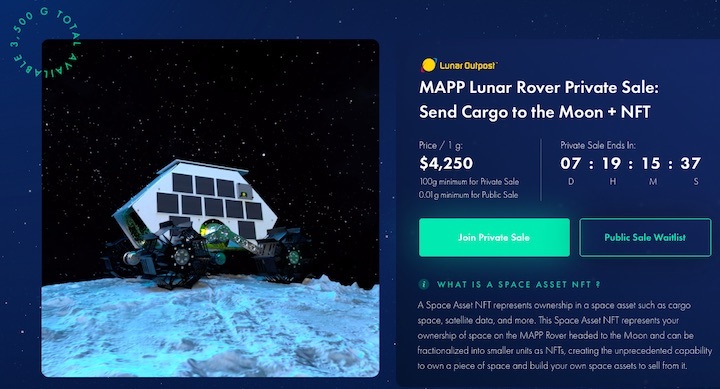18.02.2022
Copernic Space unveils platform with sale of lunar payload

SAN FRANCISCO – Copernic Space, a Los Angeles startup, unveiled its blockchain-powered platform for selling space assets. First up on the auction block is payload on a lunar rover traveling to the moon’s south pole courtesy of Lunar Outpost.
“This sets a digital commercialization standard for payload/cargo while creating a new revenue model for space by turning its ownership into a space asset available for the retail market,” Copernic Space CEO Grant Blaisdell told SpaceNews by email.
Lunar Outpost of Evergreen, Colorado, is preparing to send a 10-kilogram robotic rover to the moon on an Intuitive Machines lander and SpaceX Falcon 9 rocket later this year. While the lander’s primary payload is a Nokia LTE 4G technology demonstration, Lunar Outpost is working with Copernic Space to sell an additional 3.475 kilograms on its first Mobile Autonomous Prospecting Platform (MAPP).
Lunar Outpost’s website refers to the sale as “a historic opportunity” for a company, brand or organization focused on marketing, scientific progress or working “to establish a sustainable human presence in space.”
Copernic Space created the online platform to streamline the process of buying and selling space-related products and services like shares in a space startup, satellite sensor tasking or payload space. By applying blockchain technology, Copernic Space converts space assets into non-fungible or digital tokens, which are designed to be bought and sold online.
For the next 11 days, Lunar Outpost is selling a gram of payload capacity on its MAPP Lunar Rover for $4,250. The minimum order is 100 grams. In April, the public sale begins, allowing people to buy or sell as little as one-hundredth of a gram of payload space.
Copernic Space was founded in 2020 to help build the market for space assets to enable “the average person to own a piece of space and economically participate in the space economy,” Blaisdell said in a recent interview. Space assets converted to non-fungible tokens and can be fractionalized, or divided into smaller portions, and traded or resold.
“Selling payload in token form presents customers with a new avenue for accessing space,” Julian Cyrus, Lunar Outpost cofounder and chief operating officer, said in a statement. “In this case, not only the purchase itself but also the method of purchase is important. We hope that it leads to more payloads operating on the Moon, as well as an expansion of the number of people interested in being a part of space missions.”
Quelle: SN
----
Update: 21.02.2022
.
Startvorbereitung für SpaceX Falcon9 mit MAPP-Rover Copernic Space unveils platform


Want to own something in outer space? What about on the Moon? Lunar Outpost and Copernic Space are doing just that: expanding the public's access to space! We've teamed up to provide you with the first-ever opportunity to send physical cargo to the Moon and buy virtual ownership of it as an NFT. Launching aboard SpaceX's Falcon 9, Lunar Outpost's MAPP Rover will explore new territory on the Lunar South Pole in December 2022 and stay there for future discovery. As a participant of this space voyage, cargo ownership is tethered to a tradable Space Asset NFT which can be fractionalized and resold during the Public Sale launch in Q2 of 2022. This marks yet another historic moment as this will be the first time the retail market has economic access to real space assets.



